Browse using the new Vinous website now. Launch →
Printed by, and for the sole use of . All rights reserved © 2015 Vinous Media
113 Great Portland St,
London
W1W 6QQ
BY NEAL MARTIN | FEBRUARY 15, 2019
The Food
Sourdough & butter, culatta and Lombo charcuterie, pickled shiitake mushrooms
The Husbandry School salad, parsnips with Forge Farm honey & Berkswell, whipped cod roe, alliums & chervil, grilled brassicas with smoked egg emulsion
Whole baked Cornish turbot with roast potatoes, red cabbage and heritage carrots
Pear and almond tart, petit fours
The Wine
| 1982 Domaine René & Vincent Dauvissat Chablis La Forest 1er Cru | 97 |
| 1971 Domaine François Raveneau Chablis Les Clos Grand Cru | 86? |
| 1995 Domaine Vincent Dauvissat Chablis Les Clos Grand Cru | 97 |
| 1996 Domaine François Raveneau Chablis Les Clos Grand Cru | 96 |
| 2000 Domaine Vincent Dauvissat Chablis Les Clos Grand Cru | 91 |
| 2002 Domaine François Raveneau Chablis La Forêt 1er Cru | 96 |
| 2002 Domaine Vincent Dauvissat Chablis La Forest 1er Cru | 91 |
| 2002 Domaine François Raveneau Chablis Montée de Tonerre 1er Cru | 93 |
| 2008 Domaine Vincent Dauvissat Chablis Les Preuses Grand Cru | 96 |
| 2010 Domaine Vincent Dauvissat Chablis Les Preuses Grand Cru | 98 |
| 2010 Domaine François Raveneau Chablis Montée de Tonerre 1er Cru | 96 |
| 2011 Domaine François Raveneau Chablis Les Clos Grand Cru | 95 |
| 2011 Domaine Vincent Dauvissat Chablis Les Preuses Grand Cru | 95 |
My childhood dream was to visit the BBC Television Centre in Shepherd’s Bush, affectionately known as “the doughnut” thanks to its circular design. In my fertile brain, I imagined household names passing in and out through Aunty Beeb’s gates, gathering in studios to film Doctor Who, Are You Being Served?, Blue Peter or Top of the Pops. I pictured a self-contained magical kingdom, almost an alternate reality, where in the staff canteen Terry Wogan would be chatting in Irish brogue to fearless John Noakes, naughty Kenny Everett and that old cloth cat Bagpuss, Morecambe & Wise practicing their latest skit in the background as Basil Fawlty goose-stepped through the swing doors to order a Waldorf salad. Television Centre was the spring from which all entertainment flowed, and I vowed that when I was older, I would visit to collect my Blue Peter badge or achieve some world record confirmed by Norris McWhirter. In all probability, I would end up working at the BBC. That was my destiny. Yes, I am aware that anybody who did not grow up in England during the late seventies/early eighties will wonder what I’m going on about. But every person looks back affectionately on the childhood icons that they grew up with and that shaped how they view the world.
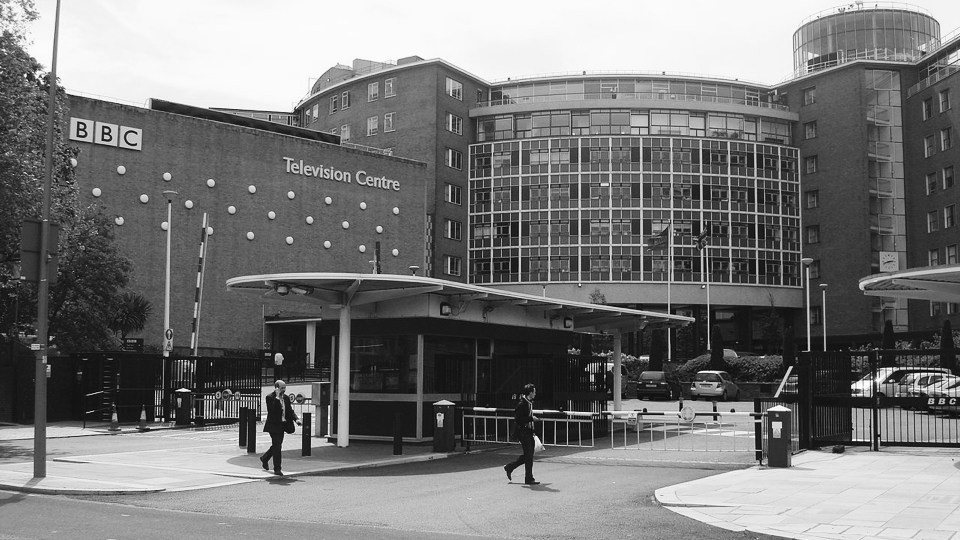
BBC television centre
Unfortunately, BBC Television Centre, with all its fixtures and fittings, all its memories, was sold off in 2013. Studios that had witnessed decades of classic television were mothballed and turned into - what a surprise - luxury flats. The BBC relocated to Regent Street in a swanky new building more cost-efficient to the taxpayer, yet bereft of charm and history. I suppose it has some advantages. According to my brother, who once worked for the BBC, he was permanently lost within the old building’s labyrinth of corridors. Another advantage is that just round the corner is one of London’s best restaurants.
Portland is located in a rather forgotten but very central part of London, just a couple of minutes’ walk from the BBC, itself just a minute’s walk from Oxford Circus. It was the venue for a memorable dinner themed around the two most revered producers of Chablis: Domaine François Raveneau and Vincent Dauvissat. Belgian wine-lover Thomas de Waen organized and supplied many of the bottles for an informal group that included Jancis Robinson and her husband, Nick Lander. Their son, Will Lander, opened Portland in January 2015 following his success with Quality Chop House in Farringdon. As soon as its doors opened, Portland received glowing reviews, prompting The Times’ restaurant critic Giles Coren to call it “a perfect restaurant.” It is medium-sized and simply furnished, emphasizing practicality rather than comfort – what you might describe as a “posh canteen,” with de rigueur open kitchen at the rear. There is usually a buzzy, youthful vibe, making it a place to meet friends rather than enjoy a romantic meal. The food, overseen by head chef Merlin Lebron-Johnson, is modern European, nothing overly fancy but often with a novel twist. Like Quality Chop House, it delves into quirkier and more esoteric domestic ingredients and recipes, as if Mrs. Beeton was offering tips in the kitchen, but enhanced by Mediterranean flair.
Wine-lovers have always flocked to enjoy an excellent wine list. Like Noble Rot, Portland operates a single bottle list of mature rarities to keep oenophiles returning on the chance of snapping up a gem. Prices were exceptionally reasonable when the restaurant first opened, though perusing the current selection suggests the wines are not quite the bargains they once were, partly because much seems to center upon Burgundy, and we all know how expensive that has become. Though one might assume Lander would follow his mum’s advice on what to pour, he has always insisted that Portland chooses its main list independently. On this occasion we dined in the basement private dining room, which is perhaps just a little claustrophobic but well-lit and cozy.
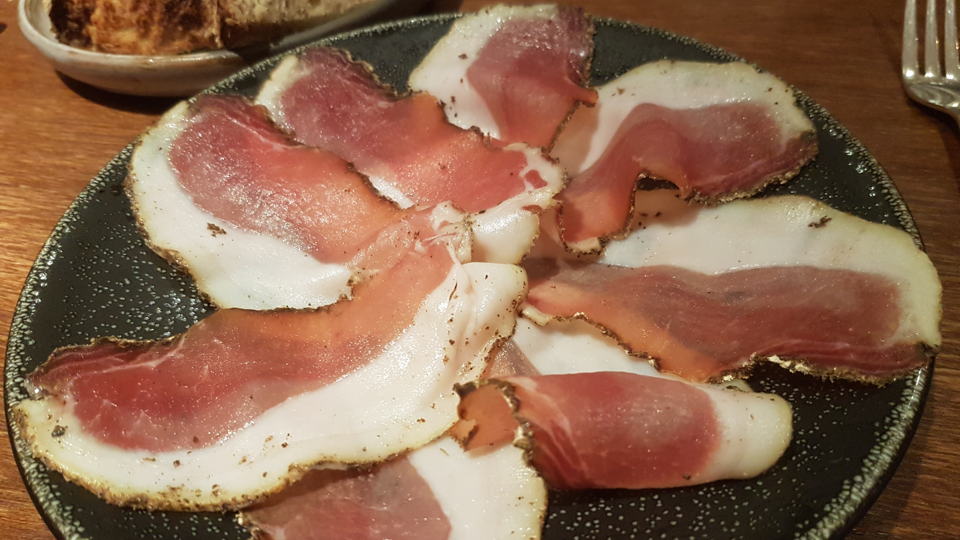
Lombo charcuterie was just one of the appetizers
We shared plates for the first two courses. The highlight of the first round was definitely the pickled shiitake mushrooms. Wow! These fungi electrified the senses, sporting the perfect degree of vinegar to keep you on your toes. The culatta and Lombo charcuterie were wonderful, lightly seasoned and devilishly “more-ish.” The second round of dishes included Husbandry School salad sourced from the namesake sustainable farm in Devon, parsnips with honey & Berkswell, whipped cod roe, alliums & chervil and grilled brassicas with smoked egg emulsion. The star was the whipped cod roe, which effortlessly matched the mature Chablis, presenting the perfect consistency and delicacy of flavor. The main performance was the whole baked Cornish turbot. Those who have read my glowing review of Brat will know that for me, turbot is the king of the fish. Whilst Brat’s emulsified turbot cannot be surpassed, this was perfectly cooked and, like the cod roe, married harmoniously with the Chablis. I have always loved the deserts at Portland, and the pear and almond tart is pretty much faultless.
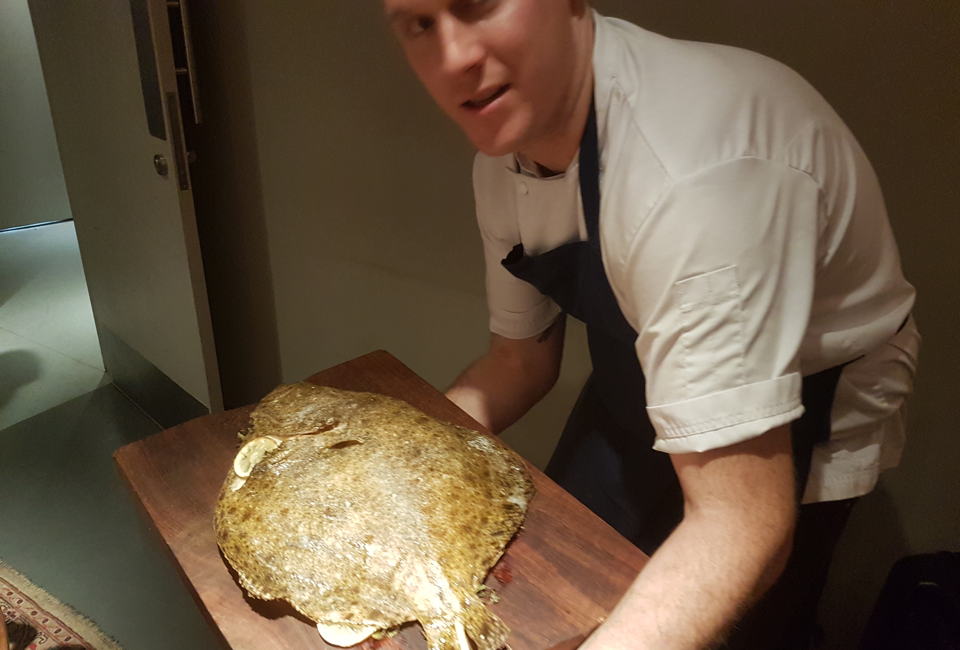
Cornish turbot presented to its audience
Before broaching the wines, let’s acknowledge that premature oxidation does exist and that it could easily have poleaxed this entire evening. Indeed, the following day, news of this dinner prompted sorry tales of premox-riddled bottles on social media. According to friends with deep collections, Vincent Dauvissat’s wines can be particularly prone, and photographic evidence of vexingly deep-colored bottles was posted on forums. As it turned out, the gods were smiling upon us this evening: there was not a single incidence of premox. Ramming home that point, Dauvissat’s wines affirmed their status as some of the most scintillating Chablis you can buy, easily holding their own against Raveneau.
So let us get on with the wines, described in the order that they were tasted.
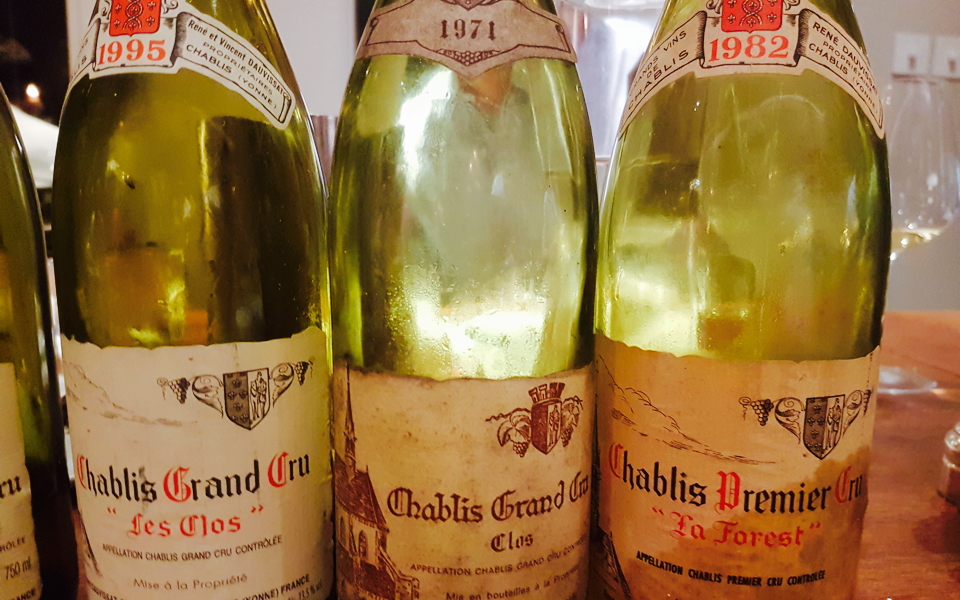
The 1982 Chablis La Forest 1er Cru, then labeled as René & Vincent Dauvissat, is burnished gold in color. The bouquet is one of the most enthralling I have discovered in aged Chablis: intense dried honey mingles with marzipan and marmalade, and a hint of blood orange emerges with time. It is utterly captivating. The palate displays exquisite balance matched by a silver thread of acidity. After so many years, this La Forest has undiminished tension and poise, entrancing energy and refinement, and a lightly spiced, oily-textured finish that leans towards Alsace. It is a brilliant Chablis that shaded what I presumed would be the highlight of the evening. The 1971 Chablis Les Clos Grand Cru was made by François Raveneau himself, since his son Jean-Marie started at the domaine in 1978. Maybe there are better bottles, but this one suggested that its peak lies in the past. Deep amber in hue, it has a slightly musty nose with muddled scents of toffee apple and molasses. Conversely, the palate is fresh and slightly viscous in style, revealing veins of lemongrass and ginger. It feels as if it must have been a concentrated Chablis in the past, but sadly, it is enervated and lacks freshness on the finish. A shame.
Dauvissat’s 1995 Chablis Les Clos Grand Cru is a stunning wine, quite deep in color, and the bouquet shimmers with energy; scents of white peach, acacia honey and baked bread, perhaps sourdough, burst from the glass with astonishing clarity. The palate is beautifully poised and feels tensile after 23 years. There is a sense of weightlessness to this Les Clos and yet it delivers absolutely everything you could desire from mature Chablis, so saline and focused on the finish that your senses wonder what hit them. Magnificent. The 1996 Chablis Les Clos Grand Cru from Raveneau is astonishingly backward on the nose, almost Zen-like, with shucked oyster shell and struck flint, and a subtle adhesive scent that emerges with time. The palate is crisp, poised and full of tension. This is unapologetically citric and steely, an uncompromising “look-me-straight-in-the-eyes” Chablis that takes no prisoners, delivering wonderful mineralité on the finish. It is a fabulous Chablis that will enjoy a very long life. The 2000 Chablis Les Clos Grand Cru from Dauvissat offers crushed stone and flecks of white chocolate on the nose, along with fleeting hints of yellow flowers and sea spray; pretty but not intellectual. The palate is supremely well balanced but much more gentle in style than its peers, and if truth be told, I am seeking more complexity on the rather conservative finish.
Nobody anticipated how well the 2002 Chablis La Forêt 1er Cru from Raveneau would show. At 16 years of age, it has a gorgeous bouquet with scents of lemon curd, white chocolate and vanilla, which makes it read more exotic than it actually is; these are fleeting glimpses amongst riveting crushed flint scents. The palate is exceptionally well balanced, delivering incredible drive and penetration, and yet the overriding impression is one of effortless grace. It is almost understated on the finish but beguiling in terms of persistence. It would be impressive for a grand cru, let alone what I feel is a premier cru that is under-appreciated by cognoscenti. What matters lies in the glass, and this delivers – big time. We were able to compare this directly with Dauvissat’s take on the vineyard that year. The 2002 Chablis La Forest 1er Cru is more primal and surly than Raveneau’s, only offering light cockleshell scents. Maybe that is a bit mean; the palate is much better, displaying impressive energy and a nigh perfect line of acidity. There is more weight compared to the Raveneau and superb persistency, yet the Raveneau wins hands down in terms of energy and terroir expression. The third wine from this vintage came from Raveneau. The 2002 Chablis Montée de Tonerre 1er Cru is a little closed at first, then introduces quirky scents of papaya and lemon curd; suggestions of aniseed develop with time. The palate is fresh and vibrant with a fine line of acidity and wonderful balance, though it becomes more orthodox towards the crushed flint and marine-tinged finish. I admire the brashness and playfulness of the aromatics matched with the more serious nature of the palate – somehow they fit together. Excellent.
The 2008 Chablis Les Preuses Grand Cru from Vincent Dauvissat comes across a little backward on the nose, but gradually unfolds to reveal limestone, granite and honeysuckle aromas. There is a sense of steeliness to the Les Preuses that I admire, though I find the aromatics less spicy than other vintages. The palate is pinned upon an absolutely killer line of acidity. This has razor-sharp mineral tension coupled with outstanding salinity, rendering it very youthful, just a tang of Seville orange marmalade and a viscous texture on the finish giving away its age. There is much potential here.
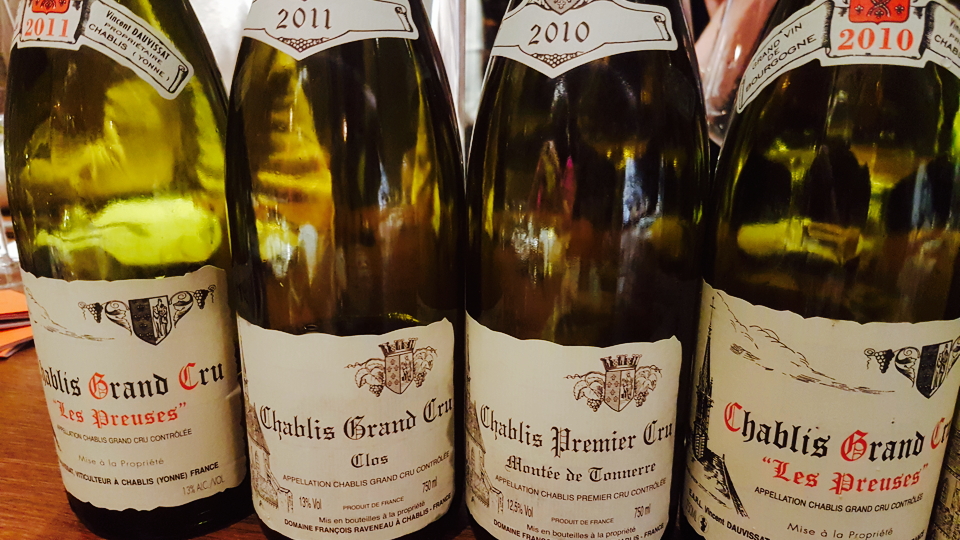
The final pairings came from the 2010 and 2011 vintages. The 2010 Chablis Les Preuses Grand Cru is one of the standouts from the best night of Chablis libation I have experienced. It has an extraordinarily intense bouquet of citrus fruit, yellow flowers, cold stone and a touch of linden. Breathtaking. The palate follows suit, delivering powerful yet refined citrus fruit that builds towards an electrifying crushed stone and orange pith finish. This is all about energy instead of overt flavors. A heavenly Les Preuses that will give 30 or even 40 years of drinking pleasure. The 2010 Chablis Montée de Tonnerre 1er Cru comes from one of Raveneau’s strongest vineyards, and it does not disappoint. The bouquet is steely and aloof at first, then suddenly turns more crystalline, bearing a strong marine influence with hints of kelp and sea spray. The balanced, penetrating palate displays a perfect line of acidity. Everything is in the right place here, culminating in what I wrote down as a “rocky” finish. Dare I say that this is about as good as Chablis can get? The 2011 Chablis Les Clos Grand Cru is as impressive as the 2010. The intense, multi-faceted nose presents apple blossom, granite, Williams pear and vervain tea aromas; you feel as if each scent is unwrapped by aeration, one by one. The palate is perfectly balanced with a taut line of acidity, quite stoic and flinty at first and then mellowing with time. It finds its groove and develops divine mandarin and saline notes on the finish. I might cellar this until it is 10 years old. Finally, the 2011 Chablis Les Preuses Grand Cru from Vincent Dauvissat. It’s a cool customer on the nose, distant and enigmatic, gradually revealing sea spray and crustacean scents, plus a touch of petrichor. The palate is wonderfully poised and harmonious, and more malic than the older vintages at this Chablis dinner, revealing hints of popcorn and sea salt on the engaging finish. This clearly needs another couple of years in bottle.

I came away from this dinner impressed by the restaurant, since the service and food had been exquisite, and with a higher appreciation of Chablis than ever before. If this evening set out to demonstrate the apotheosis of Chablis, then it is “job done.” These wines may actually have surpassed my high expectations. I kept expecting the next flight to ruin the exceptional run, but the only misstep came with the 1971 Les Clos. Everything else hit the mark. It also testified to the ageing potential of Chablis. Too many great Chablis (not least from these two growers) are martyred in their infancy, denied maturing into the ineffably complex wines they could become. Of course, I enjoyed the 2010 or 2011s; however, it was the pair from the mid-nineties where I felt I was experiencing these Chablis at their peak. Then again, that 1982 was still sparkling as it nears the big four-zero!
Walking back after the dinner, I took a shortcut past the entrance of the BBC Television Centre. I paused for a moment, just in case Roy Castle or Terry Wogan exited the revolving door. They never do and now they never will. But they made indelible impressions on my childhood, just as the wines this evening made indelible impressions on my adulthood. I never did get to work for the BBC, but then again, I’m not going to complain about the career that did fall into my lap.
My sincere thanks to Thomas de Waen for organizing this dinner and providing so many great bottles of Chablis.